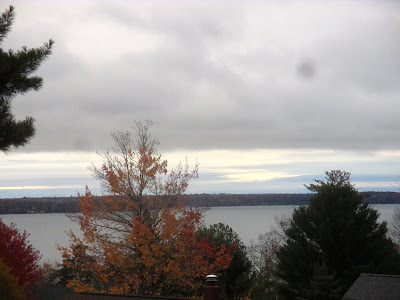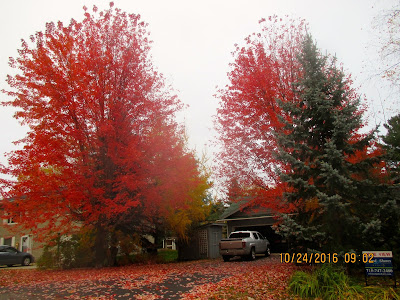 |
| FROST GRAPE TOOTHED LEAVES... |
 |
| ...A NATIVE CLIMBING VINE |
 |
| ...FRUIT CLUSTER (Google photo) |
|
Friday, 8:45 AM. 40 degrees F at the ferry dock, 38 on the back porch. Wind variable and calm, the sky partly cloudy, especially in the east. Humidity 86%, barometer 30.26" and falling. A chance of rain is predicted for Sunday AM, with temperatures in the high 30's to 50's for the next week. There was a nip in the air this morning, and fall is turning gradually to winter.
There are several species of wild grape native to eastern North America and Wisconsin, the most common being the riverbank grape,
Vitis ripparia, in the Grape Family (
Vitaceae). It is also called the frost grape, as is another native species,
V. vulpina. Both are are quite similar and bear grapes that are edible and good for wine making after a frost, thus the common name. There were no grapes on the vines I found in the woods at the end of Old Military Road, so I hesitate to give an exact name to them. Most native grapes are found further south in the state, but are obviously hardy here along the lake.
V. vuilpina is also called the fox grape, as it was reported to Linnaeus that foxes were attracted to it, and the species name refers to foxes in Latin. The species name
ripparia is Latin for riverbank.
American wild grapes are used as root grafting stock for the European wine grape,
V. vinifera, since they are cold hardy and disease resistant. Indeed, they saved the French wine industry more than a century ago when the European wine grapes suffered a devastating epidemic of fungal disease.
The University of Minnesota is working on developing a good hardy wine grape from the native species, which would extend the growing of wine grapes to far more northern latitudes.
A note of caution regarding wild grapes: the wild native moonseed,
Menispermum canadense, is poisonous, and the fruit clusters can easily be mistaken for grapes. The leaves of the moonseed vine are lobed but not toothed, and the seeds resemble a crescent moon, so careful examination will separate the moonseed vine from the grape vine.




























































